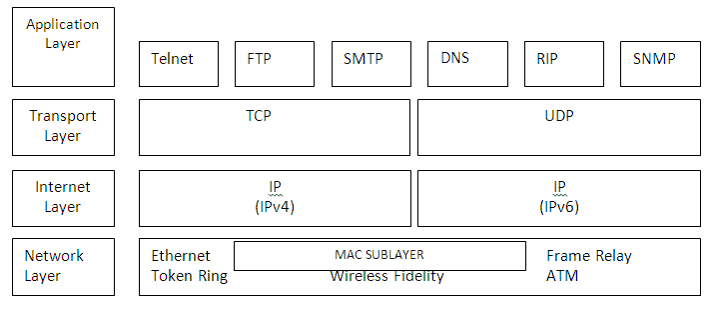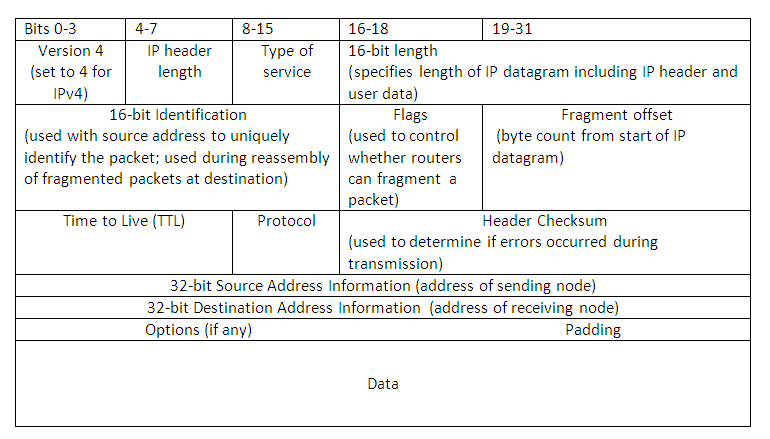Follow @ASM_Educational
Source Logical Operations
Get our complete tutorial in PDF
Configuring IPv4
- Overview of the TCP/IP Protocol Suite
- Describe IPv4 Addressing
- Implement Subnetting and Supernetting
- Configure and Troubleshoot IPv4

Comparing the OSI and TCP/IP models

IPv4 Packet

TCP/IP Applications
| Protocol | Description |
| HTTP | HyperText Transfer Protocol. Used for communication between web browsers and web servers. |
| HTTPS | HTTP Secure. Uses encryption for communication between web browsers and web servers. |
| POP3 | Post Office Protocol 3. Retrieves email messages from an email server. |
| SMTP | Simple Mail Transfer Protocol. Transfers mail over the Internet. |
| FTP | File Transfer Protocol. Transfers files between FTP servers and clients. |
| SMB | Server Message Block. Used for file and print sharing between servers and clients. |
| DNS | Domain Name Service. Converts domain names to IP addresses. |
| RDP | Remote Desktop Protocol. Allows remote control of a Windows operating system over a network. |
| DHCP | Dynamic Host Configuration Protocol. Dynamically assigns IP addresses to network clients. |
TCP/IP Sockets
- A Windows TCP/IP socket consists of three components:
- The transport protocol used by the application, either TCP or UDP
- The TCP or UDP port number used by the application
- The IP address (IPv4 or IPv6) of the source and destination host connection
- Well-known port numbers:
Port T ransport Protocol Application Service 80 TCP HTTP 443 TCP HTTPS 110 TCP POP3 25 TCP SMTP 20, 21 TCP FTP 445 TCP SMB 53 UDP DNS name lookups 53 TCP DNS zone transfers
IPv4 Addresses
- Allow for network layer data routing of IP datagrams from one IP device connection (source) to another (destination).
- Each networked device must be configured with a unique IP address.
- To make IPv4 addresses easier for humans to manage, IPv4 address formatting expresses binary bit values as dotted decimal notation.
- Each octet converts to a decimal number between 0 and 255.
Subnet Masks
- Identifies which part of the IPv4 address is the network ID and which part is the host ID.
- In its simplest implementation, the default subnet mask is either 255 or 0.
- Octets with a value of 255 identify the network ID part of the address, and a value of 0 identifies the host part of the address.
- For the IP address 192.168.1.100 and the subnet mask 255.255.255.0, the network ID is 192.168.1.0 and the host connection ID is 0.0.0.100.
Default Gateway
- Usually a router, provides a default route used by TCP/IP hosts to forward packets to hosts on remote networks.
- On a local subnet, you configure the local hosts with the IP address of the router, which is the default gateway, to enable local hosts to communicate with hosts on another network.
- Configure the default gateway:
- In the GUI in the properties of the network adapter
- Command line
- netsh interface ipv4 set address
- PowerShell
- For new IP address: new-netipaddress
- Changing an IP address: set-netipaddress
Public and Private IP Addresses
- Public IP address:
- Public IPv4 addresses, managed by IANA, must be unique
- Distributed by IANA
- ISP distributes to businesses and individuals
- Used to traverse the Internet
- Private IP address:
- Reserved by IANA
- Can be used internally by businesses and individuals
- Does not route to the Internet
- Must be NATed to allow businesses or users to connect to the Internet
- Private IPv4 address ranges established by IANA:
- 10.0.0.0/8 10.0.0.0 – 10.255.255.255
- 172.16.0.0/12 172.16.0.0 – 172.31.255.255
- 192.168.0.0/16 192.168.0.0 – 192.168.255.255
Binary Values and Dotted Decimal Notation

Unicast Address Classes with Their First Octet Values

Address Ranges for Class A, B, and C Networks

Binary ANDing

Subnetting
- Provides a means to divide your network into smaller, discrete networks that better serve the needs of your organization.
- Enables you to divide the 32 bits of an IPv4 address to create the number of subnets you need as well as the number of host addresses you need for that subnet.
Benefits of Subnetting
- Segment a large network to increase administrative efficiency.
- Reduce network congestion by limiting host broadcasts to smaller network segments.
- Increase security by isolating some hosts to a specific segment or limiting internetwork communication using firewall access controls.
- Enable proactive capacity planning based on projected growth of an organization.
Subnet Address Determination
- Determine how many subnets you need.
- Use that to determine how many bits to move the subnet mask.
| Number of Bits (n) | Number of Subnets (2n) |
| 1 | 2 |
| 2 | 4 |
| 3 | 8 |
| 4 | 16 |
| 5 | 32 |
| 6 | 64 |
| 7 | 128 |
Host Address Determination
- To determine the host bits in a subnet mask, you need to know the number of hosts you will support on a subnet.
- You use the standard formula of 2n-2, in which n represents the number of bits when calculating host bits.
- In classful addressing two host IDs are reserved, which is why you subtract two from the initial calculation.
Host Address Determination
| Number of Bits (n) | Number of Hosts (2n-2) |
| 2 | 2 |
| 3 | 6 |
| 4 | 14 |
| 5 | 30 |
| 6 | 62 |
| 7 | 126 |
| 8 | 254 |
Host Address Range Determination
| Network | Host Address Range |
| 172.16.0.0/19 | 172.16.0.1-172.16.31.254 |
| 172.16.32.0/19 | 172.16.31.1-172.16.63.254 |
| 172.16.64.0/19 | 172.16.64.1 – 172.16.64.254 |
| 172.16.96.0/19 | 172.16.96.1 – 172.16.96.254 |
| 172.16.128.0/19 | 172.16.128.1 – 172.16.128.254 |
| 172.16.160.0/19 | 172.16.160.1 – 172.16.160.254 |
| 172.16.192.0/19 | 172.16.192.1 – 172.16.223.254 |
| 172.16.224.0/19 | 172.16.224.1 -172.16.255.254 |
Supernetting
- Supernetting performs the opposite operation of subnetting.
- Combine multiple small contiguous networks into a single large network.
- Supernetting, also known as classless interdomain routing (CIDR), allows you to create a logical network for the number of hosts you require.

Supernetting (Cont.)
Combine the following networks:
| Network | Network Range |
| 192.168.14.0 | 192.168.14.1 – 192.168.14.255 |
| 192.168.15.0 | 192.168.15.0 – 192.168.15.255 |
| 192.168.16.0 | 192.168.16.0 – 192.168.16.255 |
| 192.168.17.0 | 192.168.17.0 – 192.168.17.254 |
Here is the resulting supernet:
| Network | NSupernet Mask | Network Range |
| 192.168.14.0/21 | 255.255.252.0 | 192.168.14.1 – 192.168.17.254 |
IPv4 Manual Configuration
- Servers need static IPv4 configurations to enable clients to connect to them consistently.
- You can maintain current and accurate documentation of the IPv4 addresses used for various services on your network.
- Configure them using TCP/IP properties, netsh, or PowerShell.
IPv4 Automatic Configuration
- Dynamic Host Configuration Protocol (DHCP) server enables you to configure TCP/IP addresses and other configuration options dynamically for large numbers of hosts on a network.
- DHCP servers are configured with a scope or range of IPv4 addresses.
- Clients send out a broadcast request to a DHCP server to obtain an IPv4 address automatically.
- DHCP servers also may be configured with additional configuration settings a client may require.
- Windows Server 2012 and Windows clients use automatic private IP addressing (APIPA), which is a reserved address range of 169.254.0.0 to 169.254.255.255.
IPv4 Troubleshooting Tools
- IPconfig
- Ping
- Tracert
- Pathping
- Route
- Telnet
- Netstat
- Resource Monitor
- Network Diagnostics
- Event Viewer
TCP/IP Troubleshooting Process
- Identify the communication problem
- Does it affect only one or all hosts?
- If one host, it is likely a configuration problem on the host.
- If all hosts, it is likely a server configuration problem.
- Remote connectivity could be server configuration, network configuration, or network device failure.
- For a local problem
- Verify that the local host’s TCP/IP information is configured properly.
- Ping the loopback address: 127.0.0.1.
- Ping the local host’s router.
- Ping a remote host – check firewall policies, router configuration.
Best Practices for Implementing IPv4
- Plan the subnet schema carefully and factor in future growth.
- Configure servers with static IPv4 configuration settings, and document services running on specific servers as well as IPv4 settings.
- Deploy DHCP servers for dynamic addressing for clients.
- If designing the IPv4 address space for a new network, map out the address ranges and subnets based on specific purposes and locations.
Want more information on how to become Cisco CCNA Certified? Learn more!
Join our Cisco CCNA facebook study group!
Also published on Medium.







